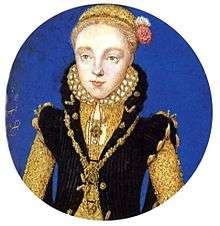Levina Teerlinc

Levina Teerlinc (b. Bruges, 1510–1520?; d. London, 23 June 1576) was a Flemish Renaissance miniaturist who served as a painter to the English court of Edward VI, Mary I and Elizabeth I.
Teerlinc was the second eldest of five sisters, the children of Simon Bening (sometimes written as Benninc or Benninck), the renowned illuminator of the Ghent-Bruges school. Bening probably trained his daughter as a manuscript painter. Teerlinc may have worked in her father’s workshop before her marriage.
Career
In 1545, she moved with her husband, George Teerlinc of Blankenberge, to England. She then served as the royal painter to Henry VIII, whose royal painter, Hans Holbein the Younger, had recently died. Her annuity for this position was £40 - rather more than Holbein had been paid.[1] Later she served as a gentlewoman in the royal households of both Mary I and Elizabeth I.
Works

Her documented works include paintings presented as gifts to the sovereign at the New Year including an image of the Trinity for Mary I in 1553. However, Teerlinc is best known for her pivotal position in the rise of the portrait miniature. There is documentation that she created numerous portraits of Elizabeth I, both individual portraits and portraits of the sovereign with important court figures. She might have trained Nicholas Hilliard, by training a goldsmith, in the methods of miniature portraiture. Hilliard would go on to be the supreme miniature portraitist of the era.
Most of these works have either not survived or are no longer attributable to Teerlinc. In fact, there are no surviving works that are unarguably documented as by her. A 1983 exhibition at the Victoria and Albert Museum represented "the first occasion when a group of miniatures has been assembled which can be attributed to Levina Teerlinc".[1] Since the exhibition also performed the same function for her predecessor as court miniaturist, Lucas Hornebolte, it was especially useful in developing consensus on attributions. Five miniatures and two illuminated manuscript sheets were in the group, including a miniature of Lady Katherine Grey from the V&A, and others from the Yale Center for British Art, the Royal Collection (both of these possibly of the young Elizabeth I, and private collections). Strong considered there was "a convincing group of miniatures that emerge as the work of a single hand, one whose draughtsmanship is weak, whose paint is thin and transparent and whose brushwork loose".[1] She also probably designed the Great Seal of England for Mary I and the earliest one used by Elizabeth.
Partial list of works
- Levina Teerlinc, Portrait of Lady Katherine Grey, About 1555–60, Victoria and Albert Museum, Museum no. P.10-1979[2]
- Levina Teerlinc, Portrait of a Young Woman, 1566, Victoria and Albert Museum, Museum no. P.21-1954[3]
- Levina Teerlinc, Portrait of Mary Dudley, Lady Sidney, ca.1575, Victoria and Albert Museum, Museum no. E.1170-1988[4]
- Levina Teerlinc?, Portrait of Queen Mary I, Collection of the Duke of Buccleuch
- Levina Teerlinc?, Portrait of a Young Woman, Collection of H.M. the Queen, Windsor Castle
- Levina Teerlinc?, Portrait of Elizabeth I in State Robes, Collection of Welbeck Abbey
See also
Notes
- 1 2 3 Strong:52
- ↑ "Portrait miniature of Katherine Grey, Countess of Herford; Katherine Grey, Countess of Hertford | Teerlinc | V&A Search the Collections". Collections.vam.ac.uk. 2014-01-09. Retrieved 2014-01-21.
- ↑ "Portrait of an unknown woman | Teerlinc, Levina (Mrs) | V&A Search the Collections". Collections.vam.ac.uk. Retrieved 2014-01-21.
- ↑ "Portrait of Mary Dudley, Lady Sidney (d.1586) | Levina Teerlinc | V&A Search the Collections". Collections.vam.ac.uk. 2014-01-09. Retrieved 2014-01-21.
References
| Wikimedia Commons has media related to Levina Teerlinc. |
- Chadwick, Whitney (1990). Women, Art, and Society. London: Thames and Hudson.
- Harris, Anne Sutherland and Linda Nochlin, Women Artists: 1550-1950, Los Angeles County Museum of Art, Knopf, New York, 1976.
- Strong, Roy: Artists of the Tudor Court: The Portrait Miniature Rediscovered, 1520-1620, Victoria & Albert Museum exhibition catalogue, 1983, ISBN 0-905209-34-6